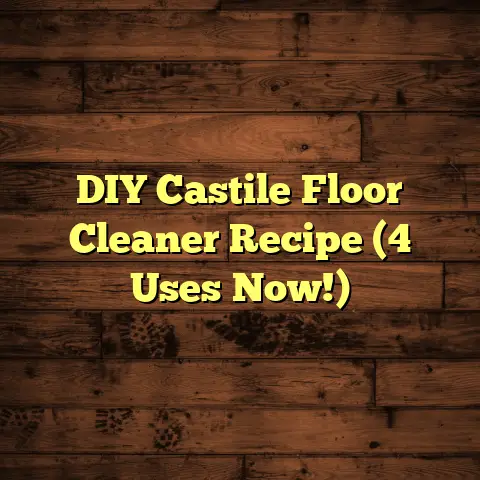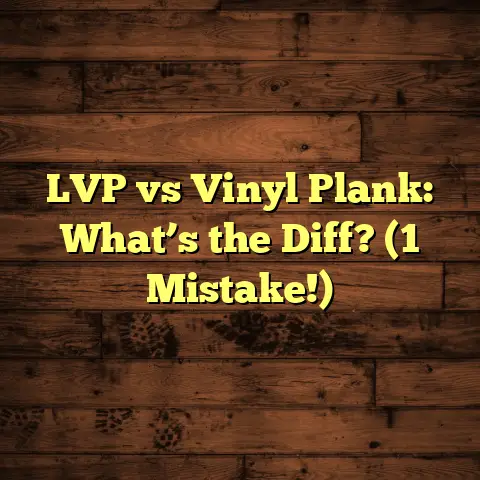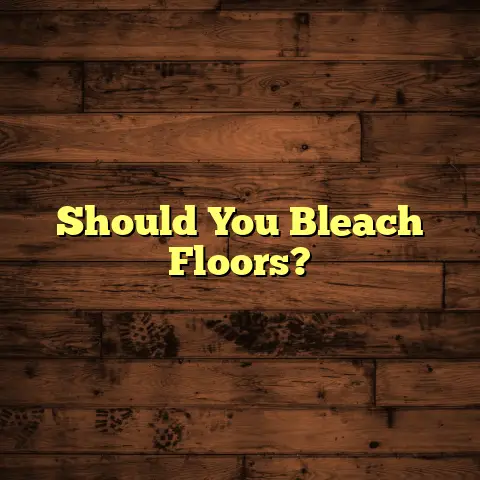Polyurethane For Hardwood? (1 Coat You’ll Regret!)
I get it! I’m a flooring contractor, and I’ve seen it all when it comes to hardwood. And let me tell you, the finish is EVERYTHING.
Here’s a scary stat: The National Wood Flooring Association says almost 80% of homeowners with hardwood floors will need to refinish them within 10 years because of bad maintenance or finish jobs. [^1]
That’s a HUGE number! And often, it boils down to skimping on the finish.
Specifically, I’m talking about polyurethane. You know, that clear coat that protects your precious wood?
Think you can get away with just one coat? Trust me, that’s a shortcut that will come back to haunt you. Let’s dive in and I’ll tell you why one coat of polyurethane is a recipe for regret.
[^1]:(Source: National Wood Flooring Association)
Understanding Polyurethane
as a Finish
So, what exactly is polyurethane?
Simply put, it’s a liquid plastic that dries into a hard, protective film. Think of it like a shield for your hardwood, guarding it against daily life.
It is composed of polymers formed by reacting an isocyanate with a polyol. This reaction creates a durable and flexible coating.
There are two main types you’ll encounter: oil-based and water-based.
Oil-Based Polyurethane
This is the classic choice. It’s known for its amber hue, which deepens over time, giving your floors a warm, rich look.
Advantages:
- Durability: Oil-based poly is tough! It stands up well to heavy foot traffic.
- Cost-Effective: Usually cheaper than water-based options.
- Penetration: It penetrates the wood grain well, offering good adhesion.
Disadvantages:
- Strong Odor: It has a potent smell during application. Ventilation is key!
- Slow Drying Time: It takes longer to dry between coats (think 8-10 hours).
- Yellowing: It ambers significantly over time, which might not be desirable for all wood types or styles.
Water-Based Polyurethane
This is the modern alternative. It’s clear and doesn’t yellow as much as oil-based, preserving the natural color of your wood.
Advantages:
- Low Odor: Much less smelly than oil-based.
- Fast Drying Time: Dries quickly, allowing for multiple coats in a day.
- Clarity: Maintains the wood’s natural color with minimal yellowing.
Disadvantages:
- Cost: Generally more expensive than oil-based.
- Durability: While improving, it’s generally considered slightly less durable than oil-based (though high-end water- based polys are closing the gap).
- Application: Can be trickier to apply evenly, requiring more attention to detail.
Polyurethane’s Role: The Protector
Regardless of the type, polyurethane’s job is to protect your hardwood from:
- Wear and Tear: Scratches from pets, shoes, and furniture.
- Moisture: Spills, tracked-in rain, and humidity.
- Stains: Food, drinks, and other accidents.
It’s like a bodyguard for your floors! But, like any good bodyguard, it needs to be properly equipped. That’s where proper application comes in.
The Importance of
Proper Application
Think of applying polyurethane like building a wall. One brick isn’t going to do much to keep the rain out, right? You need layers for strength and protection.
The same goes for polyurethane.
Application Techniques
Here’s the deal: slapping on a coat of polyurethane isn’t like painting a wall. It’s a skilled process that requires:
- Proper Prep: Sanding the floor smooth, removing all dust and debris.
- Even Application: Using a brush, roller, or applicator pad to spread the polyurethane in thin, even coats.
- Consistent Overlap: Overlapping each stroke slightly to avoid streaks or gaps.
- De-nibbing: Lightly sanding between coats to remove any imperfections.
The Coat Count Matters!
The number of coats you apply directly impacts the durability and appearance of your finish.
- One Coat: Minimal protection, prone to wear and tear, uneven appearance.
- Two Coats: Better protection, but still vulnerable in high-traffic areas.
- Three Coats: The sweet spot! Provides excellent protection and a beautiful, lasting finish.
- Four+ Coats: For extreme wear situations (like commercial spaces or homes with large, active dogs).
Common Mistakes
I’ve seen homeowners make all sorts of mistakes when applying polyurethane. Here are a few of the worst:
- Skipping Prep: Applying polyurethane over a dirty or uneven surface.
- Applying Too Thick: Thinking a thick coat equals better protection. It just leads to drips, bubbles, and slow drying.
- Not Sanding Between Coats: Leaving a rough, uneven surface.
- Using Cheap Applicators: Ending up with brush marks or lint in the finish.
- Rushing the Job: Not allowing enough drying time between coats.
And of course, the biggest mistake of all: applying only ONE coat!
The Risks of Using
Just One Coat
Okay, let’s get down to the nitty-gritty. Why is one coat of polyurethane so bad?
Imagine your hardwood floor is a knight, and the polyurethane is his armor. One thin layer of armor isn’t going to protect him from a dragon, right?
Here’s what you’re risking with a single coat of polyurethane:
- Inadequate Protection: A single coat simply doesn’t provide enough of a barrier against scratches, dents, and spills. Your floors will show wear and tear much faster.
- Moisture Damage: Polyurethane helps seal the wood, preventing moisture from penetrating and causing warping or staining. One coat offers minimal protection against spills or humidity.
- Reduced Lifespan: With minimal protection, your finish will wear away quickly, requiring you to refinish your floors much sooner than you would with multiple coats.
- Discoloration and Fading: UV rays can damage the wood beneath the finish, causing it to fade or discolor. One coat offers less UV protection.
- Uneven Appearance: A single coat may not provide a uniform sheen, resulting in a patchy or uneven look.
Real-Life Regret
I’ve seen the consequences of one-coat finishes firsthand.
I had a client, let’s call her Sarah, who tried to save some money by applying only one coat of polyurethane to her newly installed hardwood floors.
Within a year, her floors were covered in scratches from her dogs, and there were water stains around the kitchen sink. She was devastated!
She ended up having to pay me to sand down the floors and apply three proper coats of polyurethane. In the end, she spent more money than if she had done it right the first time!
I’ve also encountered situations where homeowners apply a single coat of polyurethane before putting their house on the market to save money.
While it may look okay initially, potential buyers often notice the lack of protection and durability during inspections, which can impact the sale price.
Long-Term Consequences of
Insufficient Finishing
Think of your hardwood floors as an investment. A well-maintained floor can last for decades and add significant value to your home. But a poorly finished floor? That’s a liability.
Here’s what you can expect down the road if you skimp on the polyurethane:
- Costly Repairs: Scratches and dents can be difficult and expensive to repair, especially if they penetrate the wood itself.
- Premature Refinishing: Instead of refinishing every 10-15 years, you might find yourself doing it every 3-5 years. That’s a lot of time, money, and hassle!
- Reduced Property Value: Damaged or worn-out floors can detract from the overall appearance of your home, potentially lowering its value.
- Aesthetic Issues: Over time, insufficiently protected floors can develop a dull, lifeless appearance. They might also show signs of wear in high-traffic areas, creating an uneven and unattractive look.
Think about it: are you willing to risk all of that just to save a few bucks on polyurethane?
I didn’t think so.
Best Practices for
Applying Polyurethane
Alright, now that I’ve scared you straight, let’s talk about how to do it right.
Here’s my step-by-step guide to applying polyurethane like a pro:
-
Preparation is Key:
- Clear the Room: Remove all furniture and belongings from the room.
- Clean the Floor: Sweep, vacuum, and then use a tack cloth to remove any remaining dust or debris.
- Sand the Floor: Use a floor sander to smooth out any imperfections and create a uniform surface. Start with coarse-grit sandpaper and gradually move to finer grits.
- Vacuum Again: Thoroughly vacuum the floor to remove all sanding dust.
- Tack Cloth: Use a tack cloth to pick up any remaining dust particles.
-
Application Technique:
- Choose Your Applicator: Use a high-quality brush, roller, or applicator pad designed for polyurethane.
- Apply Thin Coats: Pour a small amount of polyurethane into a paint tray. Dip your applicator into the polyurethane and apply a thin, even coat to the floor, working in the direction of the wood grain.
- Overlap Strokes: Overlap each stroke slightly to avoid streaks or gaps.
- Maintain a Wet Edge: Work quickly and efficiently to maintain a wet edge, which helps to prevent lap marks.
-
Drying and Sanding:
- Allow to Dry: Let the first coat of polyurethane dry completely according to the manufacturer’s instructions (usually 4-8 hours for water-based and 8-24 hours for oil- based).
- De-nibbing: Use a fine-grit sanding screen or sandpaper (220-grit or higher) to lightly sand the floor, removing any imperfections or raised grain.
- Vacuum and Tack Cloth: Vacuum the floor again and use a tack cloth to remove any sanding dust.
-
Repeat:
- Apply Additional Coats: Repeat steps 2 and 3, applying at least two more coats of polyurethane.
- Allow to Cure: Allow the final coat to cure completely before moving furniture back into the room (usually 24-72 hours).
Why Multiple Coats Matter
I know it’s tempting to rush the process, but trust me, multiple coats are essential for:
- Maximum Protection: Each coat adds another layer of defense against wear, moisture, and stains.
- Enhanced Durability: Multiple coats create a thicker, more resilient finish that can withstand heavy foot traffic.
- Improved Appearance: Multiple coats create a smoother, more even sheen.
- Longer Lifespan: A properly applied finish will last much longer, saving you time and money in the long run.
Quality Materials and Tools
Don’t skimp on quality! Use:
- High-Quality Polyurethane: Choose a reputable brand and the right type (oil-based or water-based) for your needs.
- Good Applicators: Invest in brushes, rollers, or applicator pads that are designed for polyurethane.
- Proper Sandpaper: Use the correct grit sandpaper for each stage of the process.
Alternatives to
Polyurethane Finishes
While polyurethane is a popular choice, it’s not the only option for finishing hardwood floors. Here are a few alternatives:
- Natural Oils: These oils penetrate the wood, providing a natural, matte finish. They’re eco-friendly and easy to repair, but they offer less protection than polyurethane. Examples include linseed oil and tung oil.
- Wax: Wax creates a beautiful, lustrous finish, but it’s not very durable and requires frequent reapplication.
- Hard-Wax Oil: This is a blend of natural oils and waxes, offering a balance of durability and natural beauty. It’s a popular choice in Europe and is gaining popularity in the US.
When to Consider Alternatives
Consider alternatives if:
- You want a more natural look and feel.
- You prioritize eco-friendliness.
- You’re willing to maintain the finish more frequently.
However, for most homeowners, polyurethane remains the best choice for its durability, ease of maintenance, and affordability.
Conclusion
So, there you have it! I’ve laid out the case against using just one coat of polyurethane on your hardwood floors.
Remember:
- Polyurethane protects your floors from wear, moisture, and stains.
- Proper application is crucial for durability and appearance.
- One coat is simply not enough!
- Insufficient finishing can lead to costly repairs and premature refinishing.
- Take the time to do it right, and you’ll enjoy beautiful, long-lasting hardwood floors for years to come.
Don’t let a single coat of polyurethane become a source of regret. Invest the time and effort to apply multiple coats, and your floors (and your wallet) will thank you for it!





